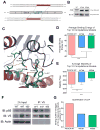PIK3CA C2 Domain Deletions Hyperactivate Phosphoinositide 3-kinase (PI3K), Generate Oncogene Dependence, and Are Exquisitely Sensitive to PI3K α Inhibitors
- PMID: 29284706
- PMCID: PMC5856622
- DOI: 10.1158/1078-0432.CCR-17-2141
PIK3CA C2 Domain Deletions Hyperactivate Phosphoinositide 3-kinase (PI3K), Generate Oncogene Dependence, and Are Exquisitely Sensitive to PI3K α Inhibitors
Erratum in
-
Correction: PIK3CA C2 Domain Deletions Hyperactivate Phosphoinositide 3-kinase (PI3K), Generate Oncogene Dependence, and Are Exquisitely Sensitive to PI3Kα Inhibitors.Clin Cancer Res. 2019 Feb 15;25(4):1432. doi: 10.1158/1078-0432.CCR-18-4269. Clin Cancer Res. 2019. PMID: 30770491 No abstract available.
Abstract
Purpose: We describe herein a novel P447_L455 deletion in the C2 domain of PIK3CA in a patient with an ER+ breast cancer with an excellent response to the PI3Kα inhibitor alpelisib. Although PIK3CA deletions are relatively rare, a significant portion of deletions cluster within amino acids 446-460 of the C2 domain, suggesting these residues are critical for p110α function.Experimental Design: A computational structural model of PIK3CAdelP447-L455 in complex with the p85 regulatory subunit and MCF10A cells expressing PIK3CAdelP447-L455 and PIK3CAH450_P458del were used to understand the phenotype of C2 domain deletions.Results: Computational modeling revealed specific favorable inter-residue contacts that would be lost as a result of the deletion, predicting a significant decrease in binding energy. Coimmunoprecipitation experiments showed reduced binding of the C2 deletion mutants with p85 compared with wild-type p110α. The MCF10A cells expressing PIK3CA C2 deletions exhibited growth factor-independent growth, an invasive phenotype, and higher phosphorylation of AKT, ERK, and S6 compared with parental MCF10A cells. All these changes were ablated by alpelisib treatment.Conclusions: C2 domain deletions in PIK3CA generate PI3K dependence and should be considered biomarkers of sensitivity to PI3K inhibitors. Clin Cancer Res; 24(6); 1426-35. ©2017 AACR.
©2017 American Association for Cancer Research.
Conflict of interest statement
Disclosure of potential conflicts of interest: R.N. and R.L. are employees of Guardant Health. J.H. and V.M. are employees of Foundation Medicine. LCC is a founder and holds equity in Agios Pharmaceuticals and Petra Pharmaceuticals, companies that are developing drugs for cancer therapy. The research in this paper does not involve drugs being developed at these companies
Figures




Similar articles
-
Correction: PIK3CA C2 Domain Deletions Hyperactivate Phosphoinositide 3-kinase (PI3K), Generate Oncogene Dependence, and Are Exquisitely Sensitive to PI3Kα Inhibitors.Clin Cancer Res. 2019 Feb 15;25(4):1432. doi: 10.1158/1078-0432.CCR-18-4269. Clin Cancer Res. 2019. PMID: 30770491 No abstract available.
-
A Phase Ib Study of Alpelisib (BYL719), a PI3Kα-Specific Inhibitor, with Letrozole in ER+/HER2- Metastatic Breast Cancer.Clin Cancer Res. 2017 Jan 1;23(1):26-34. doi: 10.1158/1078-0432.CCR-16-0134. Epub 2016 Apr 28. Clin Cancer Res. 2017. PMID: 27126994 Free PMC article. Clinical Trial.
-
Comparative molecular dynamics analyses on PIK3CA hotspot mutations with PI3Kα specific inhibitors and ATP.Comput Biol Chem. 2022 Aug;99:107726. doi: 10.1016/j.compbiolchem.2022.107726. Epub 2022 Jul 8. Comput Biol Chem. 2022. PMID: 35842959
-
Oncogenic activation of PI K3 CA in cancers: Emerging targeted therapies in precision oncology.Genes Dis. 2024 Sep 10;12(2):101430. doi: 10.1016/j.gendis.2024.101430. eCollection 2025 Mar. Genes Dis. 2024. PMID: 39717717 Free PMC article. Review.
-
Development of PI3Kα inhibitors for tumor therapy.J Biomol Struct Dyn. 2023 Oct-Nov;41(17):8587-8604. doi: 10.1080/07391102.2022.2132293. Epub 2022 Oct 11. J Biomol Struct Dyn. 2023. PMID: 36221910 Review.
Cited by
-
At a crossroads: how to translate the roles of PI3K in oncogenic and metabolic signalling into improvements in cancer therapy.Nat Rev Clin Oncol. 2022 Jul;19(7):471-485. doi: 10.1038/s41571-022-00633-1. Epub 2022 Apr 28. Nat Rev Clin Oncol. 2022. PMID: 35484287 Free PMC article. Review.
-
Advances in Therapy for Hormone Receptor (HR)-Positive, Human Epidermal Growth Factor Receptor 2 (HER2)-Negative Advanced Breast Cancer Patients Who Have Experienced Progression After Treatment with CDK4/6 Inhibitors.Onco Targets Ther. 2021 May 3;14:2929-2939. doi: 10.2147/OTT.S298720. eCollection 2021. Onco Targets Ther. 2021. PMID: 33976551 Free PMC article. Review.
-
Novel allelic variation in the Phospholipase D alpha1 gene (OsPLDα1) of wild Oryza species implies to its low expression in rice bran.Sci Rep. 2020 Apr 20;10(1):6571. doi: 10.1038/s41598-020-62649-w. Sci Rep. 2020. PMID: 32313086 Free PMC article.
-
Challenges for the Clinical Development of PI3K Inhibitors: Strategies to Improve Their Impact in Solid Tumors.Cancer Discov. 2019 Apr;9(4):482-491. doi: 10.1158/2159-8290.CD-18-1175. Epub 2019 Mar 13. Cancer Discov. 2019. PMID: 30867161 Free PMC article. Review.
-
Double PIK3CA mutations in cis increase oncogenicity and sensitivity to PI3Kα inhibitors.Science. 2019 Nov 8;366(6466):714-723. doi: 10.1126/science.aaw9032. Science. 2019. PMID: 31699932 Free PMC article.
References
Publication types
Grants and funding
LinkOut - more resources
Full Text Sources
Other Literature Sources
Miscellaneous

